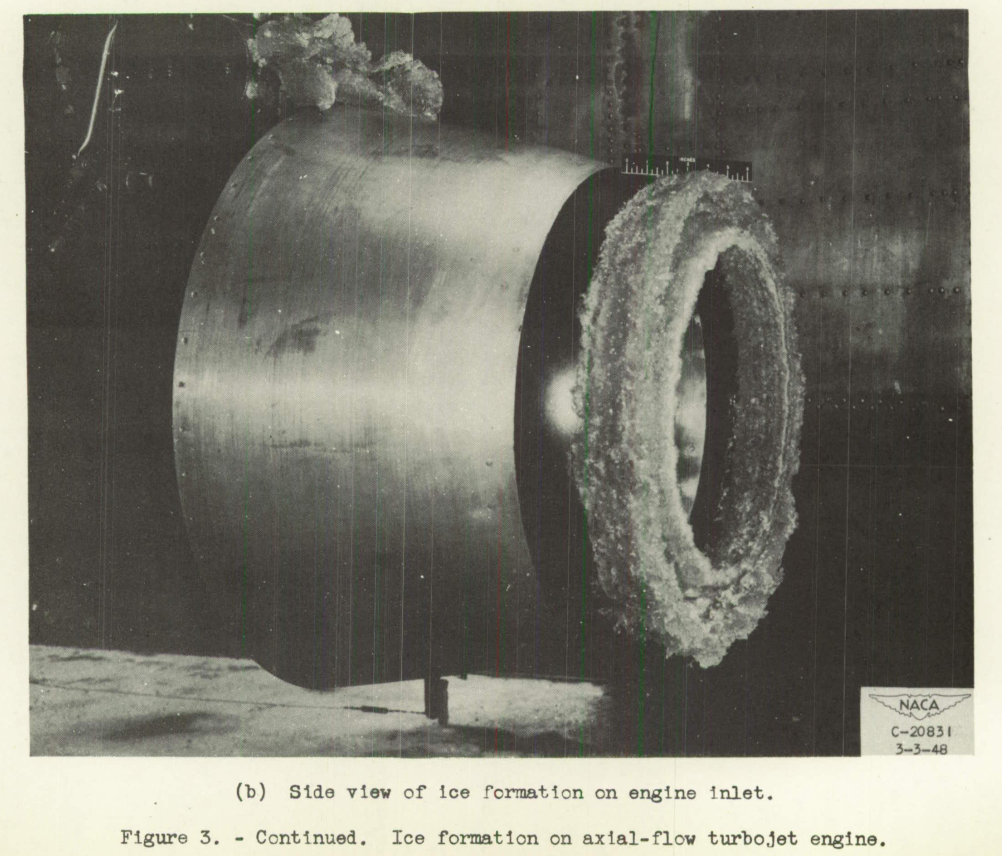"The desirability for all-weather operation of turbojet aircraft has necessitated extensive research on methods of icing protection for the various engine components"

From NACA-RM-E8C18.
Discussion
Publications taken largely from The Historical Selected Bibliography of NACA-NASA Icing Publications, "Turbine-Type Engine and Inlet Icing Studies" section are reviewed here.
Reviews
NACA-TN-1246 "Wind-Tunnel Investigation of Icing of an Engine Cooling-Fan Installation"
- "The icing of the unprotected installation presents a serious operational problem"
NACA-RM-E8C18 "Preliminary Results of Natural Icing of an Axial-Flow Turbojet Engine"
- "Ice formations penetrated to the second-stage rotor blades"
NACA-RM-E8F01a "Natural Icing of an Axial-Flow Turbojet Engine in Flight for a Single Icing Condition"
- "The engine was satisfactorily accelerated to take-off power after approximately 45 minutes in the icing condition"
NACA-TN-2126 "Improvements in Heat Transfer for Anti-Icing of Gas-Heated Airfoils with Internal Fins and Partitions"
- "Use of the hot-gas method of anti-icing has been restricted ... because of difficulty in controlling the rate of heat dissipation"
NACA-RM-E50I08 "Icing Characteristics and Anti-Icing Heat Requirements for Hollow and Internally Modified Gas-Heated Inlet Guide Vanes"
- "Ice formations ... may have the following effects, which when combined may become serious enough to necessitate a shutdown of the engine: reduced engine thrust, increased,fuel consumption, and increased tail-pipe temperature"
NACA-RM-E50E03 "Investigation of Aerodynamic and Icing Characteristics of Water-Inertia-Separation inlets for Turbojet Engines"
- "Complete icing protection for inlet guide vanes of a turbojet engine could not be achieved"
NACA-RM-E50H29 "Investigation of Power Requirements for Ice Prevention and Cyclical De-Icing of Inlet Guide Vanes with Internal Electric Heaters"
- "Experience has shown that ... the inlet guide vanes of an axial-flow turbojet engine constitute the most critical component to be protected from icing"
NACA-RM-E51B12 "NACA Investigations of Icing-Protection Systems for Turbojet-Engine Installations"
- "Serious icing of a turbojet-engine installation may render the engine inoperative in a matter of minutes."
NACA-TN-3837 "Investigation of Heat Transfer from a Stationary and Rotating Ellipsoidal Forebody of Fineness Ratio 3"
- "Many aircraft components are essentially simple bodies of revolution; examples of these are radomes, body noses, engine accessory housings, and the large spinners of turboprop engines"
NACA-TN-4093 "Investigation of Heat Transfer from a Stationary and Rotating Conical Forebody"
- "Rotational speeds up to 1200 rpm had no apparent effect on the heat-transfer characteristics of the spinner"
NACA-RM-E57G09 "Total Pressure Distortion and Recovery of Supersonic Nose Inlet with Conical Centerbody in Subsonic Icing Conditions"
- "the contour plots indicate that cowl-lip disturbances are the more controlling factor"
Related
There is also
- von Glahn, Uwe H.: Preliminary Results of Heat Transfer from a Stationary and Rotating Ellipsoidal Spinner. NACA-RM-E53F02, 1953. ntrs.nasa.gov
However, this was largely a preliminary version of NACA-TN-3837 "Investigation of Heat Transfer from a Stationary and Rotating Ellipsoidal Forebody of Fineness Ratio 3", and so it will not be separately reviewed.
See also:
Ice Protection Thread
Impingement in Ducts
Impingement in Engine Inlets